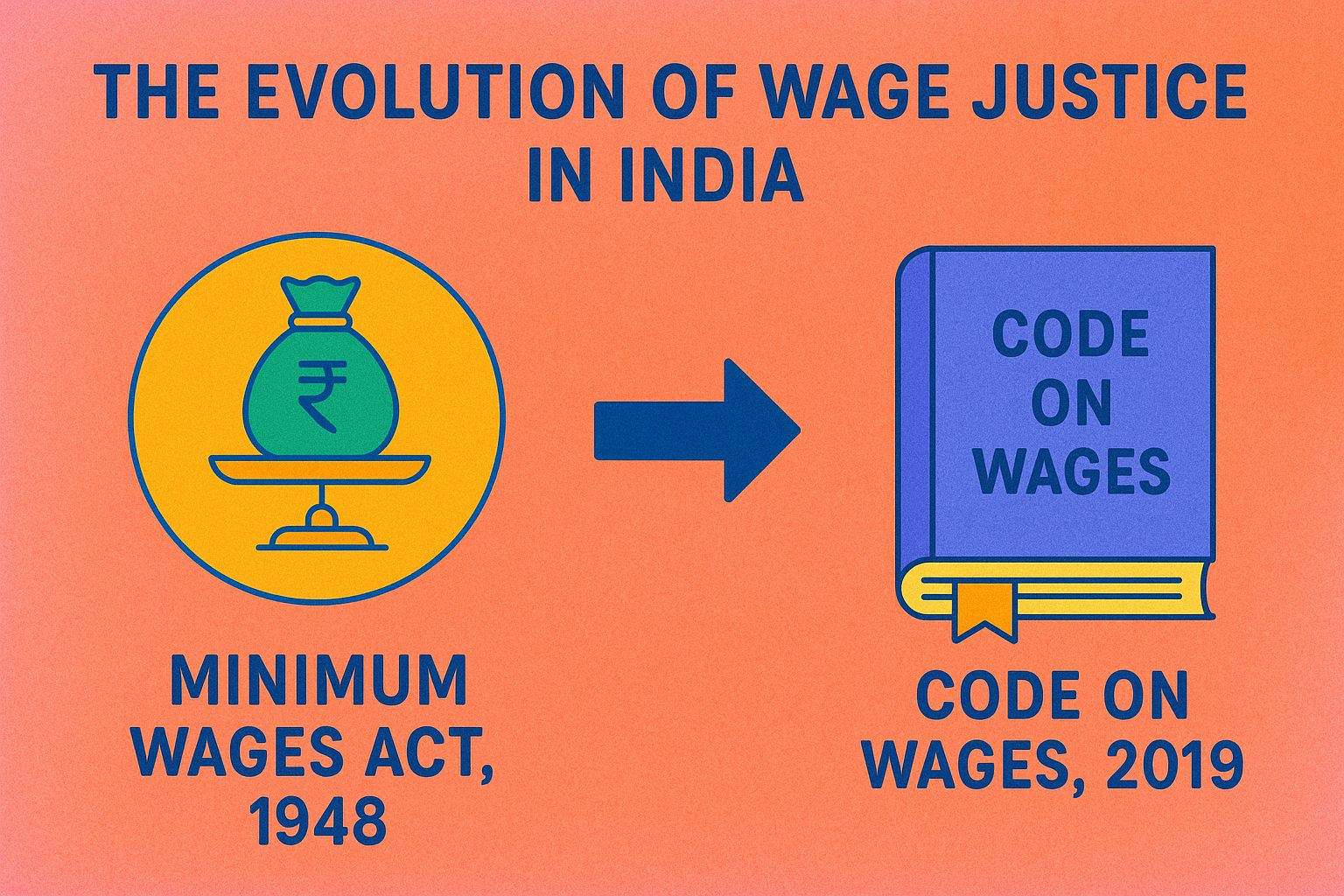By Harasees Kaur
4th Year, 8th Semester, B.A. LL.B. (Hons.), Lovely Professional University
Introduction
Wage justice is a cornerstone of any welfare-oriented democracy. In a nation like India, where a significant portion of the workforce comes from unorganised and vulnerable sectors, the concept of fair remuneration isn’t merely a policy matter—it is a tool of social transformation. Since independence, the Indian government has made considerable efforts to ensure workers are not exploited. Among these, the Minimum Wages Act of 1948 was a historic beginning. Over time, the multiplicity of laws led to complications, ultimately paving the way for the Code on Wages, 2019—a landmark in Indian labour jurisprudence.
Understanding Wage Justice
Wage justice is the assurance that a worker is compensated fairly, not just in economic terms but also with respect to their human dignity and constitutional rights. It encompasses:
• Minimum Wage: The lowest legal compensation that an employer must pay to prevent exploitation. It is not a bargaining wage; it is a statutory right.• Fair Wage: A wage that is higher than the minimum wage and takes into account the employer’s ability to pay and the industry wage level.• Living Wage: Goes beyond subsistence—it includes a decent standard of living, social security, and the ability to meet basic family needs.
These classifications are drawn from judicial interpretations and International Labour Organization (ILO) principles. The Indian judiciary has upheld them as part of the right to life under Article 21 of the Constitution.
The Minimum Wages Act, 1948: The Foundation of Wage Protection
The Minimum Wages Act, 1948 was a post-independence social welfare legislation enacted to protect workers from being paid below subsistence levels. It empowered both Central and State Governments to fix minimum rates of wages in scheduled employments.
Key Provisions:
• Section 3: Governments must fix minimum wages in scheduled employments.• Section 5: Wage fixation can be done via a committee method or notification method.• Section 7: Advisory Boards assist in wage revision.• Section 20: Provides for claims and penalties for non-compliance.
Case Law:
Unichoyi v. State of Kerala (1961) – The Supreme Court ruled that fixation of minimum wages does not infringe the freedom of business under Article 19(1)(g) because it is a reasonable restriction in the interest of public welfare.
The Equal Remuneration Act, 1976: Gender Justice in Wages
While the Minimum Wages Act protected economic rights, it did not address gender discrimination in remuneration. The Equal Remuneration Act, 1976 was enacted to fulfil the constitutional mandate of equality under Article 14 and Article 15.
Core Features:
• Equal pay for men and women for same or similar work.• No discrimination in recruitment, promotion, or conditions of service.• Establishment of Advisory Committees and grievance redressal mechanisms.
Important Case:
Mackinnon Mackenzie & Co. Ltd. v. Audrey D’Costa (1987) – It was held that equal work requires equal pay and that women doing similar work as men must be compensated equally, shifting the burden of proof onto the employer.
Challenges in the Old Wage Law Regime
Despite these efforts, the Indian wage law landscape remained fragmented and complex:
• Multiple definitions of “wages” across different laws.• Limited coverage for informal sector workers.• Procedural delays and overlapping jurisdiction between Centre and States.• Poor enforcement and lack of awareness among workers.
The need was clear: a unified, simplified, and universally applicable framework.
The Code on Wages, 2019: A Unified Legal Framework
The Code on Wages, 2019 was introduced as part of the Government’s effort to consolidate India’s labour laws into four broad codes. This particular code replaces four laws:
1. The Minimum Wages Act, 19482. The Payment of Wages Act, 19363. The Payment of Bonus Act, 19654. The Equal Remuneration Act, 1976
Major Highlights:
• Single definition of “wages” across all applications.• Applicability: To all employees, regardless of sector or wage level.• Floor Wage: Central Government to fix a “floor wage” below which no State can set its minimum wage.• Gender-neutral wage provisions.• Inspector-cum-Facilitators: For less intrusive inspections and better compliance.• Digital grievance redressal mechanisms and timelines for wage payments (e.g., by 7th/10th day of each month).
Constitutional & International Support
The principles behind wage justice are deeply rooted in the Indian Constitution:
• Article 14: Equality before law• Article 21: Right to life with dignity• Article 23: Prohibits forced labour• Article 39(d): Equal pay for equal work
Additionally, India is a signatory to several ILO conventions supporting fair wages and decent working conditions.
Ongoing Challenges
Despite progress, several issues remain:
• Implementation of the Code is pending in many states.• Workers in the gig economy (e.g., Swiggy, Zomatodelivery agents) lack clear protections.• Many employers and employees are still unaware of the new provisions.• Enforcement agencies need more resources and digital tools.
Conclusion
The journey from the Minimum Wages Act, 1948 to the Code on Wages, 2019 reflects India’s legal evolution in recognising economic rights as fundamental rights. What began as a protection against exploitation has now matured into a sophisticated wage justice system—universal, inclusive, and constitutionally grounded.
Yet, true wage justice goes beyond legislation. It requires awareness, enforcement, and empathy. As legal professionals, our duty is to uphold this justice not just in courts but in the communities that need it the most.




